| 1 | A peaceful Australian swamp lover |
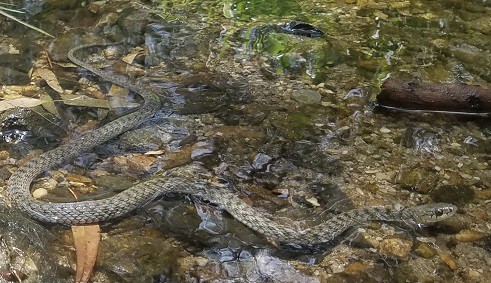
The common keelback is one of Australia’s harmless snake species. It’s native to Northern Territory and Queensland, and is the only member of the 50-strong keelback family to live in Australia (most live in southeast Asia). It possesses no venom, and lacks other freaky, fatal abilities such as constricting and spitting bees at people. Common keelbacks are far safer than other members, particularly the red-necked keelback of Thailand.
Common keelbacks aren’t fully aquatic, but are nearly always found in water. Dams, marshes, ponds and lakes are their hotspots, and they’re excellent swimmers. Common keelbacks alternate between wide open floodplains in the winter, and moist forest areas in the dry season. They commonly invade back garden ponds, and their drier bases include logs and woodpiles close to water.
At 0.5-0.75 metres, with a maximum of 1 metre, common keelbacks are a medium sized snake. There’s many colour morphs, even within one narrow location, but they’re usually a grey-olive snake, with a cream-coloured belly. The edge of each scale has dark markings, and pale skin can just be seen between the scales. Their pupils, meanwhile, are round rather than vertical.
| 2 | Toad toxin immunity |
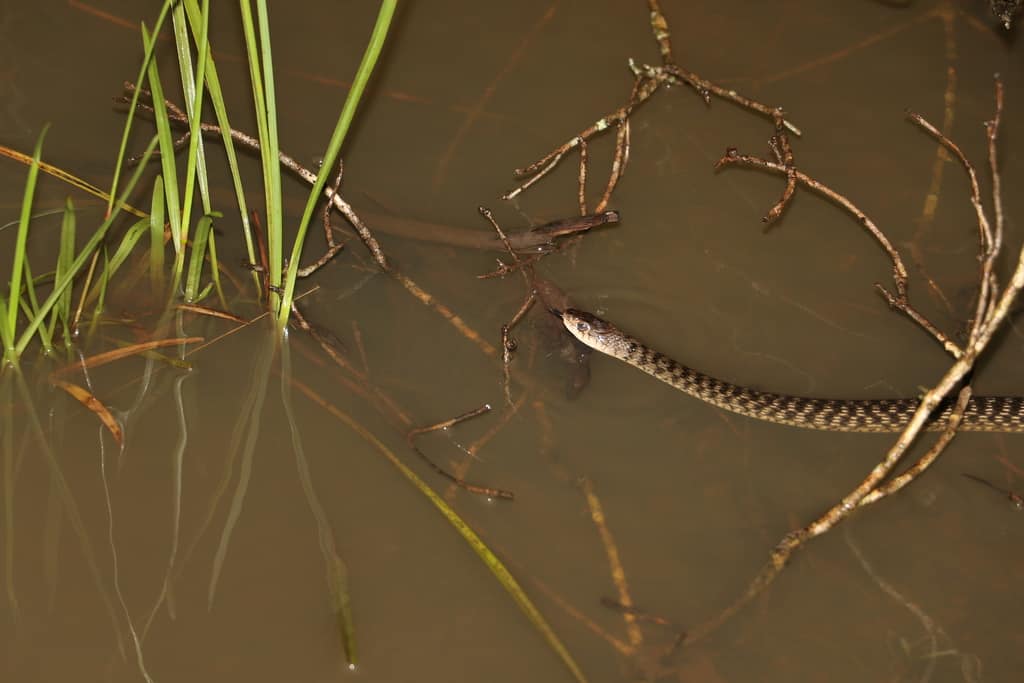
The cane toad is the greatest threat facing Australia’s snakes today. It’s an invasive species which was purposefully released in 1935, to wipe out crop-destroying cane beetles (which failed), and is loaded with heart-stopping bufotoxins.
In areas invaded by cane toads, the local snakes often disappear. All except one: the common keelback. Instead of dying after swallowing cane toads, they become sluggish for 6 hours, barely moving. Then they reactivate, going on their way again.
The red-bellied black snake is also resistant, but this only evolved over the last 60 years, due to massive survival pressure. The common keelback has been resistant all along. Scientists fed the keelback bufotoxins in areas overrun by cane toads for 60 years, and areas overrun for 3 years. The snakes survived equally well, showing that the resistance is innate.
It’s all because cane toads evolved in southeast Asia, in tandem with the keelback family. The common keelback diverged and jumped into Australia millions of years ago, but the base of evolutionary resistance remains.
| 3 | Intelligent egg laying |
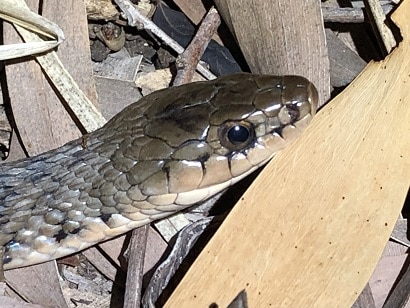
Mother common keelbacks generally lay their eggs in cracks, varying from 20-40cm deep. But one crafty tendency discovered in 2005 is to lay their eggs in places with old abandoned shells.
A special nest box was presented to 42 pregnant common keelbacks. Of those, 6 chose the empty zones, and 36 gravitated towards zones with old eggshells. Those shells were divided between two species: the common keelback (16 shells), and the slatey grey snake (20).
The mothers were clearly taking the shells as evidence that this was a decent survival spot for their young. Fresh shells did the trick, as did old dried out ones dating back 12 months.
The weirdest thing was that the slatey grey snake is actually a predator of the common keelback. They’re an egg-eating species, and keelback eggs are a top choice. Somehow, the keelback had no aversion to these predator shells, which shows that they rely more on visuals than smell (which would have sent them running a mile). Mother common keelbacks may be smart, but their intellect has limits.
| 4 | Not the bravest snake |
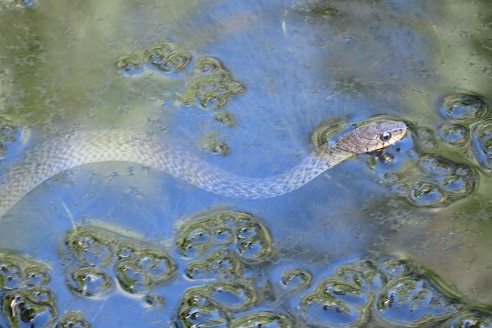
Common keelbacks have an automatic instinct to take shelter, as they’re commonly preyed on by hawks and owls. They can be extremely difficult to spot in a lake, as their default is to hide in vegetation, whether in moist pond weeds or overhanging tree branches.
Another bird-dodging trick is to immediately submerge themselves underwater, the moment they detect a shadow overhead. Some hide beneath rocks, and they can even detach their tail if picked up, which doesn’t grow back. Scientists have noticed that pregnant common keelbacks flee much further across water, to protect their unborn snakelets, whereas cocky young males tend to stay put, sometimes to a dangerously overconfident extent.
Common keelbacks have an extreme Australian lookalike which does have venom: the rough-scaled snake. There are technical differences in scale layout, but the easiest ID is the common keelback’s extremely keeled (rough) scales. From a distance, these resemble parallel ridges running down their back. Ironically, the rough-scaled snake is slightly less rough, and those ridges are flatter.
| 5 | How the species was discovered |
The details were lost to time for many decades, but have finally been unearthed again. John Mair was a surgeon who waged a noble battle against smallpox during the 15 years he spent in Sydney. In 1843, he returned to Canada and became a devout Christian, campaigning against the perils of alcohol using biblical quotes.
What’s weird is that despite being credited with the discovery, John Mair mainly stuck to Sydney, far from the keelback’s northern empire. It’s now believed that the original 1831 keelback was collected by Captain Collett Barker, another member of Mair’s 39th regiment. Unfortunately, on the way back from Queensland, Barker swam across the Murray River, ran over a sandhill, and was never seen again.
He turned out to have been killed by angry indigenous people, assuming that he was a whaler or sealer, who had previously abducted their women. His men didn’t retaliate for fear of enraging the aboriginals further, but collected his belongings. They are believed to have fallen to John Mair, who dispatched the preserved keelback to England, and received the proud credit of the Latin name: Tropidonophis mairii.
| 6 | Also immune to native toxins |
Cane toads aren’t the only amphibian the common keelback is resistant to. Australia also has a native, non-invasive frog which is loaded with toxins. It’s called Dahl’s aquatic frog (Litoria dahlii), and few snakes can eat it without rolling over and dying.
In 1994, scientists gathered various Australian snakes, and fed them Dahl’s aquatic frogs no more than 20% of their body mass. These included the children’s python, green tree snake, slatey grey snake, and northern death adder.
The snakes were force-fed, but the common keelback didn’t require any force. It grabbed the frogs as they were dangled centimetres away, and greedily gobbled them down. Every other snake resisted the force feeding, pushing hard and trying desperately to escape.
After swallowing the frog, the common keelback survived with no injuries. All the other snakes died, most immediately. Most became jerky and uncoordinated, a frothy mucous pouring from their mouths. One water python died after merely touching the Dahl’s waterfrog. Only the black whipsnake managed to survive an extra 12 hours.
The common keelback might be tame, but it must feel cool to be a walking shield against poison.
| 7 | Diet: prefers frogs to toads |
Despite its cane toad resistance, common keelbacks only eat them very occasionally. Some were hoping for common keelbacks to rise up and eat the entire invasive population, but that glorious fightback won’t happen, as toads are a poor source of nutrition for them. In north Queensland wetlands, scientists found that 89% of prey inside the local keelbacks were frogs. Only a single toad was identified. There was no shortage either: the combined population of the 10 nearby frog species was less than the nearby toad population.
One species they’re confirmed to gobble up is the ornate burrowing frog (Opisthodon ornatus). This is a small, 5cm Queensland resident, which digs backwards into soft muds using its feet. Another name is the “backwards sliding burrower”, and its call is a recognisable “unk” sound.
A 2010 study found their favourite species to be the striped burrowing frog (Cyclorana alboguttata), with the spotted grass frog (Limnodynastes tasmaniensis) and eastern dwarf tree frog (Litoria fallax) not far behind.
| 8 | Can’t move at below 20C |
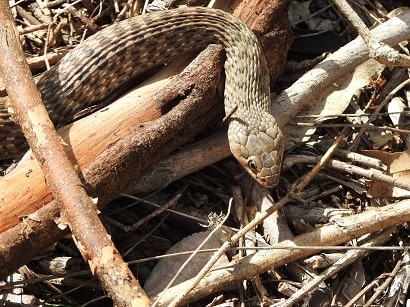
Common keelbacks don’t restrict themselves to night or day. Instead, their actions are forever intertwined with the ambient air temperature. During warmer weather, the local keelbacks come out of hiding, while during cold weather, they suddenly disappear, leaving local Queenslanders utterly confused as they walk past their local lake.
Common keelbacks have a specific temperature cutoff, as when the air falls below 20 degrees, they stop moving entirely. But they’re much stronger against high temperatures, barely slowing down at 35 centigrade plus.
As you’d expect, this impacts their seasonal movements, and your chances of bumping into one. In winter (June-August), common keelbacks move by far the least, partly because this is dry season as well. But the flipside is that most of their movement is confined to daylight – 87% according to one study.
In summer (December-February), common keelbacks can be active during night or day, with a slight preference towards night. The same study found that in Feb-March, 43% of their movements were by day.
| 9 | A true breeding machine |
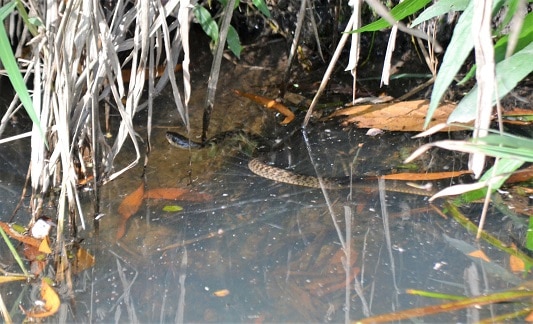
Common keelbacks are an egg-laying snake, usually 4-18. The larger the female, the larger the eggs they produce. Common keelbacks are particularly renowned for regularly producing 2 clutches per year. They’re a breeding machine, as one study captured 460 females during breeding season, and found that 80% were pregnant.
Common keelbacks have a month when they reach peak fatness (not fitness): January, after gorging on spring and summer frogs for months beforehand. Their first batch of hatchlings comes in May-June, and beforehand, young females are so fat that they can lay egg and grow a few inches simultaneously.
Batch 2 arrives from September-November, and is much trickier, as their fat reserves are ground down. It’s dependent on whether the common keelback can scrape together enough food during the lean winter months. Consequently, female common keelbacks grow much less during this second birth phase. Scientists have dubbed batch 1 a “capital” breeding strategy (using body stores) vs an income strategy for batch 2.
| 10 | Plentiful, not endangered |
A special feature of common keelback is that when seizing frogs (and occasionally toads), they always go for the hind legs first. The blunted tree snake, meanwhile, also starts with the head.
Common keelbacks aren’t a threatened species by any means. In permanent bodies of water, like ponds and marshes, the frogs are also permanent, and they can gorge themselves silly. They live a carefree life (excluding those owls and hawks) where food is never an issue and they can go swimming whenever they want. One such paradise is Fogg Dam Conservation Reserve, a frog haven 50km southeast of Darwin. This is one place where common keelbacks produce multiple clutches per year, because food is so plentiful that there’s never any stress. It wouldn’t be a bad species to be if reincarnation turns out to be real.
Something a common keelback can’t guard against is stupidity though. One captive keelback was recorded being eaten by a red-bellied black snake. All was well, except that the red-belly measured just 1.3 metres next to the keelback’s 1 metre. The red-belly’s plan failed, and it was forced to regurgitate the keelback, which was now dead.
